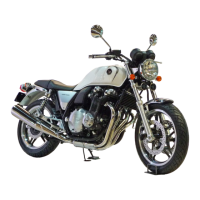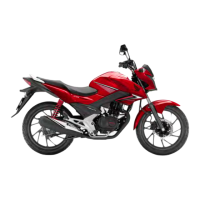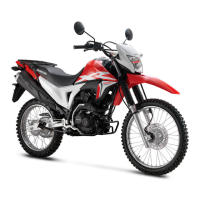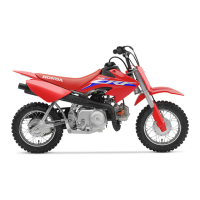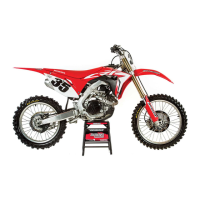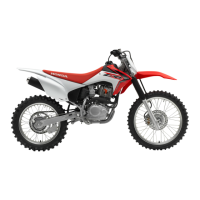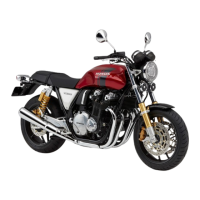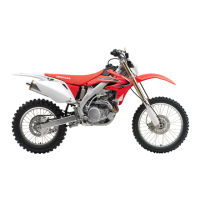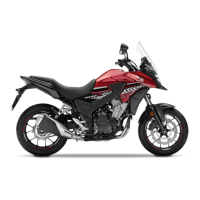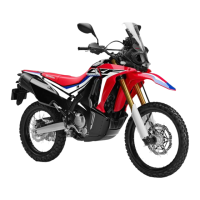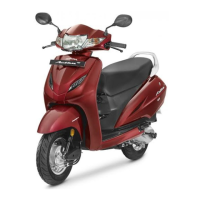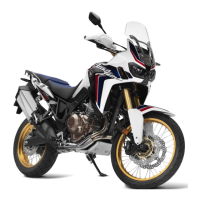Do you have a question about the Honda MSX125SF 2017 and is the answer not in the manual?
Information about the Customer Relation Section and its purpose.
Contact details and working hours for the Customer Relation Section.
Welcomes the customer and highlights Honda's reputation.
Key points for ensuring safety and riding pleasure from the manual.
Lists country codes used in the manual for different regions.
Explains the meaning of DANGER, WARNING, and CAUTION signal words.
Refers to other important safety information provided in the manual.
Guidelines to enhance rider safety and motorcycle operation.
Essential precautions to ensure safe riding and protection.
Precautions to follow while operating the motorcycle.
Advice and warnings regarding safe use of accessories and modifications.
Guidelines for securely and safely loading the motorcycle.
Emphasizes wearing a helmet and protective gear for maximum safety.
Key checks and conditions to ensure before starting to ride.
Recommends practice in a safe area to build familiarity with the motorcycle.
Advises awareness of surroundings and defensive riding techniques.
Tips to increase visibility to other drivers.
Advises riding within personal abilities and prevailing conditions.
Warns against combining alcohol and riding.
Importance of regular maintenance for safe riding.
Steps to take if involved in a motorcycle crash.
Information about the dangers of carbon monoxide exhaust.
Details on required protective clothing for riding.
Specifics on helmet standards and proper fit.
Recommendations for suitable motorcycle riding gloves.
Recommendations for suitable footwear for motorcycle riding.
Guidelines for protective jackets and trousers.
Guidelines for the initial running-in period of the motorcycle.
Precautions and guidelines for using the brakes effectively.
Explanation of how engine braking works and its use.
Precautions for riding in wet or rainy weather.
Instructions for safely parking the motorcycle.
Steps for parking the motorcycle using the side stand.
Guidelines for safe and proper refuelling.
Warnings and advice regarding safe use of accessories and modifications.
Guidelines for securely and safely loading the motorcycle.
Steps for inspecting the motorcycle before riding.
Procedure for starting the motorcycle's engine.
Explanation of the motorcycle's gear shifting pattern.
Guidance on applying throttle and obeying speed limits.
Refers to various controls and features for basic operation.
Instructions on how to brake the motorcycle effectively.
Procedure for safely pulling over and stopping.
Techniques for turning corners safely.
Steps for parking the motorcycle.
Instructions for refuelling the motorcycle.
Identifies key parts of the motorcycle and their locations.
Explanation of the motorcycle's instrument panel.
Details about the tachometer and its function.
Procedure to check the instrument display functionality.
Information about the speedometer and its readings.
Explanation of the fuel gauge and low fuel indication.
Explains the odometer and tripmeter functions and controls.
Information about the clock display.
Step-by-step guide to setting the motorcycle's clock.
Explains the various indicator lights on the instrument panel.
Meaning and behavior of the PGM-FI malfunction indicator.
Indicates the function of the turn signal indicators.
Explains the high beam indicator light.
Explains the neutral indicator light.
Identifies and explains the function of various switches.
Operation and safety of the engine stop switch.
Controls for switching between high and low beams.
Operation of the turn signal switch.
Operation of the horn.
Operation of the engine start button.
Controls for the headlight, taillight, and license plate light.
Operation of the ignition switch.
How to lock the steering.
Instructions on how to release and retract the ignition key.
Procedure for starting the motorcycle's engine.
Troubleshooting steps if the engine fails to start.
Explanation of the motorcycle's gear shifting pattern.
Instructions on how to refuel the motorcycle safely.
Location and use of helmet holder, tool kit, and document bag.
Explains why regular maintenance is crucial for safety and performance.
Provides a schedule for routine maintenance tasks.
Basic principles and checks for motorcycle maintenance.
Information about the tools included in the kit.
Procedures for removing and installing body parts.
Information related to the motorcycle battery.
Procedure for removing and installing the seat.
Steps for checking and replacing the spark plug.
Procedures for checking and changing engine oil.
Maintenance procedures for the brake system.
Checks for the side stand.
Maintenance procedures for the drive chain.
Emphasizes the necessity of keeping the motorcycle well-maintained.
Safety guidelines to follow when performing maintenance.
Details the schedule for required maintenance tasks.
Detailed table outlining maintenance items and their frequency.
Continues the table of maintenance items and frequencies.
Essential checks to perform before riding the motorcycle.
Guidelines for using genuine or equivalent parts for replacement.
Information on the maintenance-free battery and terminal cleaning.
Explanation of fuse functions and replacement procedures.
Guidelines for selecting and checking engine oil.
Information on checking and using brake fluid.
Inspection of the drive chain and sprockets.
Procedure for cleaning and lubricating the drive chain.
Service instructions for the crankcase breather.
Procedures for inspecting and replacing tyres.
How to check tyre tread wear indicators.
Guidelines for replacing motorcycle tyres correctly.
Information on the air cleaner element and its servicing.
Description of the tools provided in the motorcycle's tool kit.
Steps for removing and installing the motorcycle battery.
Procedures for removing and installing the motorcycle seat.
Detailed steps for checking the spark plug.
How to check and adjust the spark plug gap.
Procedure for checking the engine oil level.
Instructions for adding engine oil to the motorcycle.
Recommendation to have the dealer change engine oil.
Steps to follow when changing the engine oil.
Procedure for checking the brake fluid level in reservoirs.
Steps for inspecting the condition of brake pads.
How to adjust the brakelight switch for proper operation.
How to check the side stand for smooth operation and spring condition.
Procedure for inspecting the drive chain slack.
Steps for adjusting the drive chain slack.
Continues the steps for adjusting drive chain slack.
How to check for wear in the drive chain.
How to check the clutch lever freeplay and cable.
Procedure for adjusting clutch lever freeplay using the upper adjuster.
Procedure for adjusting clutch lever freeplay using the lower adjuster.
How to check throttle operation and freeplay.
Procedure for cleaning the crankcase breather tube.
How to adjust the vertical aim of the headlight.
Guide to diagnosing and resolving common motorcycle issues.
Troubleshooting steps for when the engine does not start.
Explains warning lights and indicators.
Meaning and behavior of the PGM-FI malfunction indicator.
Information on other warning indicators and signals.
How to interpret fuel gauge failure indications.
Advice on handling tyre punctures and repairs.
Procedure for emergency tyre repair using a kit.
Steps to remove wheels for tyre repair.
Steps for removing the front wheel of the motorcycle.
Steps for installing the front wheel of the motorcycle.
Steps for removing the rear wheel of the motorcycle.
Steps for installing the rear wheel of the motorcycle.
Instruction to adjust the drive chain after wheel installation.
Common electrical issues and their solutions.
Steps to take when the motorcycle battery is dead.
Procedure for replacing burned-out light bulbs.
Information on headlight bulb replacement.
Information on brake and tail light LEDs.
Procedure for replacing turn signal bulbs.
Procedure for replacing the license plate light bulb.
Steps for checking and replacing blown fuses.
Potential causes and actions for unstable engine running.
Information about motorcycle keys and their management.
Details on instruments, controls, and additional features.
Guidelines for cleaning and maintaining the motorcycle.
Guidelines for storing the motorcycle.
Instructions for safely transporting the motorcycle.
Information on environmental responsibility.
Location and importance of frame and engine serial numbers.
Information on using fuels with alcohol content.
Information about the catalytic converter.
Guidelines for cleaning and protecting motorcycle panels.
Cleaning advice for exhaust pipe and muffler.
Detailed steps for storing the motorcycle for extended periods.
Guidelines for transporting the motorcycle securely.
Recommendations for eco-friendly cleaning products.
Proper disposal methods for hazardous motorcycle waste.
Cleaning advice for aluminium parts to prevent corrosion.
Additional tips for storing the motorcycle, including battery care.
Procedures for transporting the motorcycle using trailers or straps.
How to enjoy riding while protecting the environment.
Location and importance of frame and engine serial numbers.
Information on using fuels with alcohol content.
Guidelines to protect the motorcycle's catalytic converter.
Key physical and dimensional specifications of the motorcycle.
Details on tyre size, air pressure, spark plugs, and engine oil.
Torque values for various bolts and nuts.
Specifications for motorcycle bulbs.
Specifications for fuses used in the motorcycle.
Information about the Customer Relation Section and its purpose.
Contact details and working hours for the Customer Relation Section.
Welcomes the customer and highlights Honda's reputation.
Key points for ensuring safety and riding pleasure from the manual.
Lists country codes used in the manual for different regions.
Explains the meaning of DANGER, WARNING, and CAUTION signal words.
Refers to other important safety information provided in the manual.
Guidelines to enhance rider safety and motorcycle operation.
Essential precautions to ensure safe riding and protection.
Precautions to follow while operating the motorcycle.
Advice and warnings regarding safe use of accessories and modifications.
Guidelines for securely and safely loading the motorcycle.
Emphasizes wearing a helmet and protective gear for maximum safety.
Key checks and conditions to ensure before starting to ride.
Recommends practice in a safe area to build familiarity with the motorcycle.
Advises awareness of surroundings and defensive riding techniques.
Tips to increase visibility to other drivers.
Advises riding within personal abilities and prevailing conditions.
Warns against combining alcohol and riding.
Importance of regular maintenance for safe riding.
Steps to take if involved in a motorcycle crash.
Information about the dangers of carbon monoxide exhaust.
Details on required protective clothing for riding.
Specifics on helmet standards and proper fit.
Recommendations for suitable motorcycle riding gloves.
Recommendations for suitable footwear for motorcycle riding.
Guidelines for protective jackets and trousers.
Guidelines for the initial running-in period of the motorcycle.
Precautions and guidelines for using the brakes effectively.
Explanation of how engine braking works and its use.
Precautions for riding in wet or rainy weather.
Instructions for safely parking the motorcycle.
Steps for parking the motorcycle using the side stand.
Guidelines for safe and proper refuelling.
Warnings and advice regarding safe use of accessories and modifications.
Guidelines for securely and safely loading the motorcycle.
Steps for inspecting the motorcycle before riding.
Procedure for starting the motorcycle's engine.
Explanation of the motorcycle's gear shifting pattern.
Guidance on applying throttle and obeying speed limits.
Refers to various controls and features for basic operation.
Instructions on how to brake the motorcycle effectively.
Procedure for safely pulling over and stopping.
Techniques for turning corners safely.
Steps for parking the motorcycle.
Instructions for refuelling the motorcycle.
Identifies key parts of the motorcycle and their locations.
Explanation of the motorcycle's instrument panel.
Details about the tachometer and its function.
Procedure to check the instrument display functionality.
Information about the speedometer and its readings.
Explanation of the fuel gauge and low fuel indication.
Explains the odometer and tripmeter functions and controls.
Information about the clock display.
Step-by-step guide to setting the motorcycle's clock.
Explains the various indicator lights on the instrument panel.
Meaning and behavior of the PGM-FI malfunction indicator.
Indicates the function of the turn signal indicators.
Explains the high beam indicator light.
Explains the neutral indicator light.
Identifies and explains the function of various switches.
Operation and safety of the engine stop switch.
Controls for switching between high and low beams.
Operation of the turn signal switch.
Operation of the horn.
Operation of the engine start button.
Controls for the headlight, taillight, and license plate light.
Operation of the ignition switch.
How to lock the steering.
Instructions on how to release and retract the ignition key.
Procedure for starting the motorcycle's engine.
Troubleshooting steps if the engine fails to start.
Explanation of the motorcycle's gear shifting pattern.
Instructions on how to refuel the motorcycle safely.
Location and use of helmet holder, tool kit, and document bag.
Explains why regular maintenance is crucial for safety and performance.
Provides a schedule for routine maintenance tasks.
Basic principles and checks for motorcycle maintenance.
Information about the tools included in the kit.
Procedures for removing and installing body parts.
Information related to the motorcycle battery.
Procedure for removing and installing the seat.
Steps for checking and replacing the spark plug.
Procedures for checking and changing engine oil.
Maintenance procedures for the brake system.
Checks for the side stand.
Maintenance procedures for the drive chain.
Emphasizes the necessity of keeping the motorcycle well-maintained.
Safety guidelines to follow when performing maintenance.
Details the schedule for required maintenance tasks.
Detailed table outlining maintenance items and their frequency.
Continues the table of maintenance items and frequencies.
Essential checks to perform before riding the motorcycle.
Guidelines for using genuine or equivalent parts for replacement.
Information on the maintenance-free battery and terminal cleaning.
Explanation of fuse functions and replacement procedures.
Guidelines for selecting and checking engine oil.
Information on checking and using brake fluid.
Inspection of the drive chain and sprockets.
Procedure for cleaning and lubricating the drive chain.
Service instructions for the crankcase breather.
Procedures for inspecting and replacing tyres.
How to check tyre tread wear indicators.
Guidelines for replacing motorcycle tyres correctly.
Information on the air cleaner element and its servicing.
Description of the tools provided in the motorcycle's tool kit.
Steps for removing and installing the motorcycle battery.
Procedures for removing and installing the motorcycle seat.
Detailed steps for checking the spark plug.
How to check and adjust the spark plug gap.
Procedure for checking the engine oil level.
Instructions for adding engine oil to the motorcycle.
Recommendation to have the dealer change engine oil.
Steps to follow when changing the engine oil.
Procedure for checking the brake fluid level in reservoirs.
Steps for inspecting the condition of brake pads.
How to adjust the brakelight switch for proper operation.
How to check the side stand for smooth operation and spring condition.
Procedure for inspecting the drive chain slack.
Steps for adjusting the drive chain slack.
Continues the steps for adjusting drive chain slack.
How to check for wear in the drive chain.
How to check the clutch lever freeplay and cable.
Procedure for adjusting clutch lever freeplay using the upper adjuster.
Procedure for adjusting clutch lever freeplay using the lower adjuster.
How to check throttle operation and freeplay.
Procedure for cleaning the crankcase breather tube.
How to adjust the vertical aim of the headlight.
Guide to diagnosing and resolving common motorcycle issues.
Troubleshooting steps for when the engine does not start.
Explains warning lights and indicators.
Meaning and behavior of the PGM-FI malfunction indicator.
Information on other warning indicators and signals.
How to interpret fuel gauge failure indications.
Advice on handling tyre punctures and repairs.
Procedure for emergency tyre repair using a kit.
Steps to remove wheels for tyre repair.
Steps for removing the front wheel of the motorcycle.
Steps for installing the front wheel of the motorcycle.
Steps for removing the rear wheel of the motorcycle.
Steps for installing the rear wheel of the motorcycle.
Instruction to adjust the drive chain after wheel installation.
Common electrical issues and their solutions.
Steps to take when the motorcycle battery is dead.
Procedure for replacing burned-out light bulbs.
Information on headlight bulb replacement.
Information on brake and tail light LEDs.
Procedure for replacing turn signal bulbs.
Procedure for replacing the license plate light bulb.
Steps for checking and replacing blown fuses.
Potential causes and actions for unstable engine running.
Information about motorcycle keys and their management.
Details on instruments, controls, and additional features.
Guidelines for cleaning and maintaining the motorcycle.
Guidelines for storing the motorcycle.
Instructions for safely transporting the motorcycle.
Information on environmental responsibility.
Location and importance of frame and engine serial numbers.
Information on using fuels with alcohol content.
Information about the catalytic converter.
Guidelines for cleaning and protecting motorcycle panels.
Cleaning advice for exhaust pipe and muffler.
Detailed steps for storing the motorcycle for extended periods.
Guidelines for transporting the motorcycle securely.
Recommendations for eco-friendly cleaning products.
Proper disposal methods for hazardous motorcycle waste.
Cleaning advice for aluminium parts to prevent corrosion.
Additional tips for storing the motorcycle, including battery care.
Procedures for transporting the motorcycle using trailers or straps.
How to enjoy riding while protecting the environment.
Location and importance of frame and engine serial numbers.
Information on using fuels with alcohol content.
Guidelines to protect the motorcycle's catalytic converter.
Key physical and dimensional specifications of the motorcycle.
Details on tyre size, air pressure, spark plugs, and engine oil.
Torque values for various bolts and nuts.
Specifications for motorcycle bulbs.
Specifications for fuses used in the motorcycle.
| Fuel System | PGM-FI electronic fuel injection |
|---|---|
| Transmission | 4-speed |
| Front Suspension | Inverted telescopic fork |
| Rear Suspension | Monoshock |
| Front Tire | 120/70-12 |
| Rear Tire | 130/70-12 |
| Seat Height | 765 mm |
| Fuel Tank Capacity | 5.5 liters |
| Curb Weight | 107 kg |
| Bore x Stroke | 52.4 mm x 57.9 mm |
| Compression Ratio | 9.3:1 |
| Starter | Electric |
| Final Drive | Chain |
| Engine Type | Air-cooled, 4-stroke, single cylinder |
| Front Brake | Single 220mm disc with two-piston caliper |
| Rear Brake | Single 190mm disc with single-piston caliper |
| Dry Weight | 101.7 kg |
| Max Torque | 11 Nm (8.1 lb-ft) @ 5250 rpm |
| Wheelbase | 1200mm |
